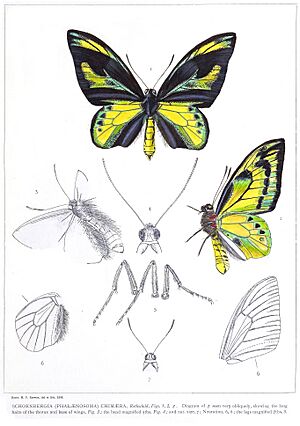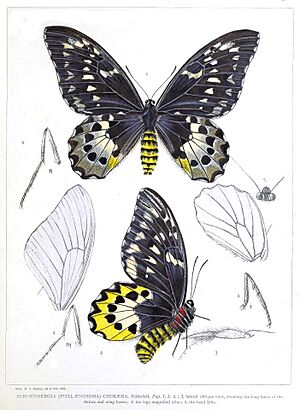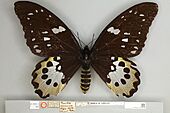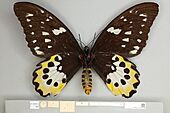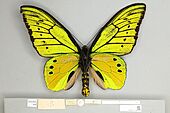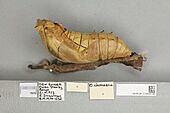Chimaera birdwing facts for kids
Quick facts for kids Chimaera birdwing |
|
|---|---|
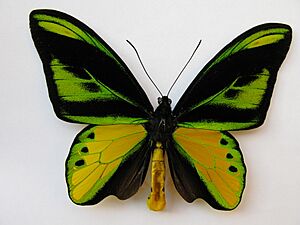 |
|
| Male | |
 |
|
| Female | |
| Conservation status | |
| Scientific classification |
The chimaera birdwing (Ornithoptera chimaera) is a truly amazing butterfly! It's part of the birdwing family, known for their large size and beautiful colors. You can find these special butterflies living in the mountains of New Guinea, often high up, about 1000 meters (over 3,000 feet) above sea level.
Its name, "chimaera," comes from an old Greek story about a creature called the Chimaera. This mythical beast was made up of parts from different animals, just like how this butterfly has a mix of colors and patterns.
Contents
Discovering the Chimaera Birdwing
Chimaera birdwings look different depending on if they are a male or a female. This is called sexual dimorphism. This means the males and females have different appearances.
Size and Appearance
These butterflies are quite large! Females can have a wingspan of 80 to 180 millimeters (about 3 to 7 inches). Males are a bit smaller, with a wingspan of 70 to 150 millimeters (about 2.7 to 6 inches).
Male Butterflies: The males have mostly black front wings. They have two bright green areas on these wings. The underside of their front wings is also green. The edges of the wings and the veins (the lines on the wings) are black. You might see small black spots near the outer edge of the wing.
Their back wings are mostly green. They have some large, shiny golden spots and a few black spots. The underside of the back wings is also green with golden and black spots.
The body of the male butterfly is bright yellow. Its head and the part of its body where the wings attach (the thorax) are black. Underneath the thorax, there are two small red fluffy parts.
Female Butterflies: The females are larger than the males. Their main color is dark brown. On their front wings, they have a line of white spots near the outer edge. They also have other white spots closer to the center of the wing.
On their back wings, there is a large white area. The outer edge of this white area is yellow. Between the white and yellow parts, there is a line of black spots.
Types of Chimaera Birdwings
Scientists have found a few different types, or subspecies, of the chimaera birdwing:
- Ornithoptera chimaera chimaera
- Ornithoptera chimaera charybdis (discovered in 1915)
- Ornithoptera chimaera flavidior (discovered in 1913)
Where to Find Them
The chimaera birdwing lives in the mountains of New Guinea. They prefer the rainforests found in the Central Range.
What They Eat
The baby butterflies, called larvae or caterpillars, eat leaves from a plant called Aristolochia. One type they like is Aristolochia momandul. The female butterfly can lay up to 20 eggs on these leaves.
Adult butterflies drink nectar from flowers. They like the nectar from Spathodea trees, which are sometimes called "African tulip trees." They also enjoy nectar from Hibiscus flowers. You might see groups of both male and female butterflies flying around the tops of these trees, high up in the canopy.
Protecting the Chimaera Birdwing
The chimaera birdwing is a special butterfly, and efforts are being made to protect it. It is listed on CITES Appendix II. This means that international trade of these butterflies, or any parts of them, is controlled. People need special permits to buy or sell them across borders. This helps to make sure too many are not taken from the wild.
The butterfly is also considered "near threatened" by the IUCN (International Union for Conservation of Nature). This means that while it's not in immediate danger, its population could become threatened if we don't protect its habitat and control trade.
Gallery
- Selection of museum specimens of Ornithoptera chimaera
See also
- Fauna of New Guinea



